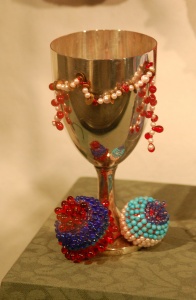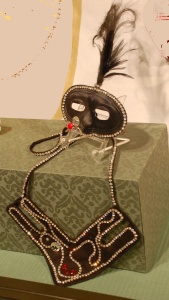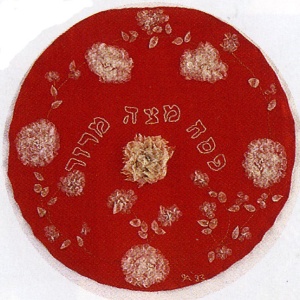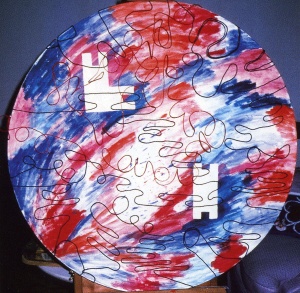Ita Aber at Yeshiva University Museum
Could there be such a thing as Women’s Art? From my liberal modernist perspective such a notion is foreign, threatening and, indeed, heretical. I have long clung to the belief that art is a universal value, a vast spectrum of aesthetic experience that, with the tools of modernist form and patient understanding, can be understood despite its national origin and gender orientation. Ita Aber’s work has taught me otherwise and a good selection of it is on view now at the Yeshiva University Museum until October 14, 2007. Women’s art, at least as I perceive it in her work, operates with a different aesthetic, one rooted in objects and sensibilities that seem to be unique to women.
Let me explain.
Whimsy is seldom seen in the august canons of classical Western Art. And yet in Ita Aber’s work it is celebrated. The first wall case is dedicated to the Jewish holidays and is overflowing with playful accolades to holiday simcha. The backdrop of a Succah wall covering is festooned with succah hangings made with stuffed colored fabric richly decorated with beads, jangles, and ribbons. Floating above is a “Messianic” stuffed fish (a golden, purple, rust colored striped Leviathan with hanging beaded fins), a giant esrog, strawberries, pears and of course, joyful hearts. Everything is extra large, hence its messianic flavor. Perhaps only a woman could be so overtly joyful in a material way.

Competing with Succos are a bevy of Passover objects, chief among them stuffed frogs and one adorable big green locust. This cute but deadly fella has pale green satin wings and is encrusted with a kind of plague of his own, dew-like round beads that catch the light marking him as a celestial messenger for sure.

Ita’s Miriam Cup is an essay in counter-intuitive aesthetics. Just below the rim the cup is pierced in three places to accommodate a jangle of white and coral beads that ornament the shiny sterling silver becher. Attached to the base are two colorful beaded representations of pomegranates. The lushness of this object evokes fertility and the full spectrum of 613 mitzvos. How to drink from it is another story.

Purim takes on a unique cast with Ita’s emphasis on the mask as a symbol of feminine mystery and allure. Central to a woman’s power is that which is withheld; the unseen becoming easily as important as that which is revealed. Here Aber has no less than five Purim masks, each covered with different colored cloth, beads, some with pearls, others boasting red, white and blue stripes and all mixing the notion of concealment with symbolic gesture. Her Purim Mask and Body Ornament is especially intriguing; a simple black mask ringed with glass rhinestones attached to her signature “Gamma” shaped frontlet, equally encrusted with rhinestones and red sapphire accents. The Gamma, the third letter in the Greek alphabet, is an ancient symbol used by Roman-era Jews to distinguish women’s garments from men’s clothing (usually marked with the Eta, the 7th letter in the Greek alphabet). These two symbols are used extensively by Aber in her work to address the relationship between female and male and their possibilities.
The next display case expands Ita’s purview of what is artistically possible with a woman’s perspective. There are semi-abstract woven wall hangings meant to frame an Aron HaKodesh, each with Hebrew letters embroidered here and there; a girl’s naming dress in simple white decorated delicately with two stitched Magen David and a posuk proclaimed at the ceremony. A startling mobile is made up of two Gammas and two Etas effectively in balance and grounded by one clear Lucite Gamma dangling opposite a clear Lucite Eta above, a kind of hopeful plea for gender harmony.
Ita Aber is a great proponent of jewelry as personal expression. She comments that originally jewelry was used for many different purposes: promoting and protecting health, warding off evil spirits, promoting livelihood, protecting the unborn and finally, attracting the opposite sex. Many of these amulet-like functions still operate on some level today. As a woman chooses what jewelry to wear she asks herself, “What do I feel like today?” perhaps meaning what do I want my jewelry to do for me today?
The amulet, a spiritual tool to influence the world around us, was traditionally fashioned and used by women and is an important theme that runs through Aber’s work. As Ita considered this art form over the years she recently began to fashion beaded cases much like those for amulets but here used for mezuzot. She has effectively invented a rich new form for mezuzah cases.
Some of her jewelry / body ornament incorporates the Gamma, embroidered in red and festooned with tiny Bedouin coins as a proclamation sexual independence, while other pieces return to whimsy as the guiding aesthetic. The intriguing necklace of blue plastic translucent abstract shapes promises to jingle as it moves with its wearer. Only after we are told that the pieces are actually shoehorns routinely given to first class passengers on El Al do we fully appreciate the wit and ingenuity of Aber’s art.
One of my personal favorites are the Esther/Vashti Pendants. The three dimensional inverted triangle of sterling silver and gold sports three slender pendants of its own, supporting three perfectly round spheres. The use of classic female forms (the inverted triangle and the sphere) are grounded by the straight vertical lines etched in silver.
Prayer garments for women are rare but not unknown and Ita has made a number over the years. This vest-like silk garment has representations of four corners decorated with Gammas, ardently defining it as a specifically woman’s garment. An embroidered atarah abstractly embraces the wearer’s neck. Ita based this garment on one she restored years ago at the Jewish Museum that was from Eastern Europe and dated to the late 18th or early 19th century. One can fully appreciate the kind of power this must have exerted on a woman’s concentration in prayer. Holy thoughts justly demand special clothes. Men have their talis and tefillin, a black hat and gartel. Why not women?

Opposite this large display case is a wall of framed works where the same motifs are further explored imaginatively and concretely. By now it has sunk in how much Aber’s work focuses intensely on issues of gender using specifically women’s media. The ancient art of fish-scale embroidery is found in both a simple sampler and a large elaborate red matzah cover. Her round

Celestial Sphere (just acquired by YUM) summons a world view of dizzying diversity. Painted primary colors suggest land masses and seas while an energetic three dimensional squiggle of painted cord activates the conceptual atmosphere in high relief. Brass disks arbitrarily anchor the four points of the compass as the placid elemental shapes of gender, the Gamma and Eta, float in the firmament. A woman’s art defines the world.
Ita Aber has been around. Over her long career she has created works of art in embroidering, beadwork, sewing, appliqué, silkscreen, jewelry design, weaving, painting, sculpture and assemblage. She has added to our collective knowledge as a conservator of textiles, an art historian, a curator, author and teacher.
And so what does one do when a new kind of aesthetic appears on the horizon? Creatively incorporate that part of its vision that finds a personal resonance, of course. And most importantly, look more carefully at other artists who may share this aesthetic. And certainly gratitude is in order. One must tip one’s hat to Ita Aber and say to her Women’s Art; “Well done, sister!”
Ita – B’Ita in her Time
60 Years of Creativity by Ita Aber
Yeshiva University Museum – Center for Jewish History
15 West 16th Street, New York, N.Y.
www.yumuseum.org